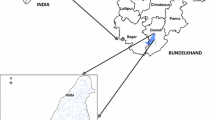Abstract
This study is to assess the hydrological drought in South Korea in a semi-distributed form using an equation modifying the SWSI (Surface Water Supply Index). Based on the nationwide gauging stations of 61 precipitation, 53 streamflow, 7 dam inflow and 31 groundwater level, South Korea was divided into 32 (sub-regions) and 112 (accounting units) watersheds. The evaluation result was compared with the historical drought records of 2001 which is the driest year in history. The results showed that the monthly-based SWSI value of the 112 watersheds division gives a more reliable representation than that of the 32 watersheds division. In addition, the weekly-based SWSI evaluation accurately showed the continual drought condition while the monthly-based evaluation failed to catch the drought within a month.
Similar content being viewed by others
References
Alley, W. M. (1984). “The Palmer drought severity index: Limitations and assumptions.” J. Climate and Appl. Meteorology, Vol. 23, No. 7, pp. 1100–1109.
Alley, W. M. (1985). “The Palmer drought severity index as a measure of hydrologic drought.” Water Resour. Bulletin, Vol. 21, No. 1, pp. 105–114.
Bordi, I., Fraedrich, K., Petitta, M., and Sutera, A. (2005). “Methods for predicting drought occurrences.” Proceedings of the 6th EWRA International Conference, Menton, France.
Cancelliere, A., Di Mauro, G., Bonaccorso, B., and Rossi, G. (2007). “Stochastic forecasting of drought indices.” Methods and Tools For Drought Analysis and Management, In: Rossi, G., Vega, T., Bonaccorso, B. (eds.), Water Science and Technology Library, Vol. 62, Springer, Dordrecht, pp. 83–100.
Cancelliere, A., Rossi, G., and Ancarani, A., (1996). “Use of Palmer index as drought indicator in Mediterranean regions.” Proceedings of the IAHR Congress “From flood to drought,” Sun City, South Africa, Vol. 4, pp. 1–25.
Dezman, L. E., Sharer, B. A., Simpson, H. D., and Danielson, J. A. (1982). “Development of a surface water supply index-A drought severity indicator for Colorado.” Int. Syrup. Hydrometeorology, Proc., American Water Resour. Association (AWRA), Bethesda, Md., pp. 337–341.
Easterling, W. E. (1988). “Coping with drought hazard: Recent progress and research priorities.” Natural Disasters in European Mediterranean Countries, NSF and NRC, In: Siccard, F. and Bras, R. L. (eds), Perugia (Italy), pp. 231–270.
Gibbs, W. J. (1975). Drought — its definitions, delineations and effects, Special Environment Report: Drought, Vol. 5, WMO, Geneva.
Karl, T., Quinlan, F., and Ezell, D. S. (1986). “Drought termination and amelioration: Its climatological probability.” J. Clim. Appl. Meteorol., Vol. 26, pp. 1198–1209.
Lohani, V. K., Loganathan, G. V., and Mostaghimi, S. (1998). “Longterm analysis and short-term forecasting of dry spells by Palmer drought severity index.” Nord. Hydrol., Vol. 29, No. 1, pp. 21–40.
McKee, T. B., Doesken, N. J., and Kleist, J. (1993). “The relationship of drought frequency and duration to time scales.” In Preprints, 8th Conference on Applied Climatology, Anaheim, CA, pp. 79–184.
Palmer, W. C. (1965). Meteorological drought, Research paper No. 45, U.S. Weather Bureau, Washington, D.C.
Rossi, G., Benedini, M., Tsakiris, G., and Giakoumakis, S. (1992). “On regional drought estimation and analysis.” Water Resour. Manage., Vol. 6, pp. 249–277.
Shafer, B. A. and Dezman, L. E. (1982). “Development of surface water supply index to assess the severity of drought condition in snowpack runoff areas.” Proc. of Western Snow Conf., pp. 164–175.
Wilhite, D. A. (2000). Drought. A global assessment for drought, Westview Press, Boulder.
Wilhite, D. A. and Glantz, H. M. (1987). “Understanding the drought phenomenon: The role of definitions.” In Planning for Drought: Towards a Reduction of Society Vulnerability, Wilhite, D. A.
Easterling, E. A., Wood, D. A. (eds.). Westview Press: Colorado, pp. 11–27.
Yevjevich, V., Da Cunha, L., and Vlachos, E. (1983) Coping with droughts, Water Resources Publication, Littleton, Colorado.
Author information
Authors and Affiliations
Corresponding author
Rights and permissions
About this article
Cite this article
Kwon, HJ., Kim, SJ. Assessment of distributed hydrological drought based on hydrological unit map using SWSI drought index in South Korea. KSCE J Civ Eng 14, 923–929 (2010). https://doi.org/10.1007/s12205-010-0827-8
Received:
Accepted:
Published:
Issue Date:
DOI: https://doi.org/10.1007/s12205-010-0827-8




